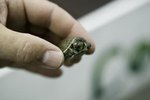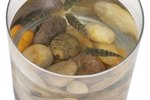Things You'll Need
Small tank or pet carrier
Gravel or pebbles
Water
Earthworms
Tadpoles
Baby snapping turtles need specific care, especially during the first few years of their life. Your turtle may be just two inches long now, but he will double in size every year until he reaches his adult size, which will be anywhere from 12 to 18 inches. If you take care of him during his first few years of growth, your turtle will be happy and healthy when he reaches adulthood.
Buy a three-gallon tank or even a small hamster carrier (found in most pet stores) for your baby turtle’s home. Add gravel or smooth pebbles to the bottom of the tank, along with one to three inches of water. Make sure he has enough water to submerge himself, but don’t make the water deeper than the height of his shell. Snappers like to lie on the bottom of their tank and stretch their mouths up to the surface to breathe while they sleep. If your snapper has no place to rest in the water and breathe, he could drown from having to constantly swim.
Find him some food. Snapping turtles are carnivores, but not very picky about their meat. They eat earthworms, small fish and tadpoles, and later on in life, frogs and baby mice. Most pet stores carry live food, so you don’t have to catch your own earthworms. Snapping turtles also eat live insects such as crickets or mealworms, something many pet stores sell.
Buy him some turtle pellets (Reptomin is a good one) and aquarium vegetation like Elodea (water weeds) as well, to balance out his diet.
But don’t over-feed your turtle. If his skin looks tight and his legs bulge from his shell, cut back on his food. If his skin appears loose and saggy, feed him a little bit more.
Keep a close eye on his bottom shell. If anything in the tank is irritating him, the injured area will turn orange in comparison to the surrounding areas, and small pinholes will appear. If this occurs, remove the gravel or pebbles from the tank and consult a pet store expert as to what kind of terrain you should replace it with. If his symptoms persist even after his environment has been repaired, contact a vet.
Clean your snapper’s shell once or twice a month with a soft, used toothbrush (but clean it first!). Brush lukewarm water gently into the crevices and crannies of both the upper and lower shell.
Buy fluorescent bulbs for your aquarium if it is not in a location that receives direct sunlight. Bulbs that contain UVB are best. Most pet stores have these bulbs readily available, as are the larger aquariums you will need to buy as your pet grows.
Use a heating lamp to maintain the tank's temperature, especially if you live in a cold climate. The ideal temperature for snapping turtles is around 70 degrees Fahrenheit.
Tips
Snapping turtles grow very quickly. Most snapping turtles will double in size until they reach one foot in length. At that point, they will need very large tanks or an outdoor pond to live in.
To save yourself from frequent tank cleaning, feed your snapper in a separate enclosure. This way you’ll only need to clean the tank once a week, rather than every few days.
References
Writer Bio
Ellen Goodlett has been a writer since 1999. Her work has been published in the "Pittsburgh Post-Gazette" and "Nimbus" magazine. Goodlett holds a bachelor’s degree in linguistics and languages from Bryn Mawr College.





